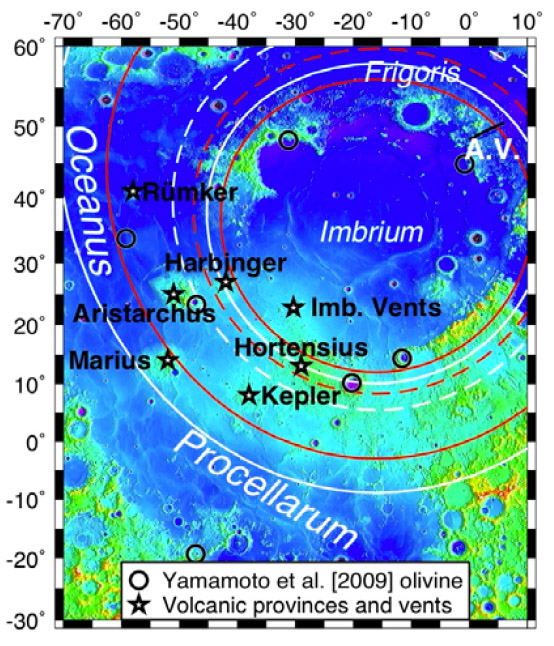Difference between revisions of "January 30, 2011"
(Created page with "__NOTOC__ =Why Volcanoes Are Where They Are= <!-- ws:start:WikiTextHeadingRule:0:<h1> --> <em>image from [mailto:tychocrater@yahoo.com Chuck Wood]</em><br /> <br />...") |
|||
| (9 intermediate revisions by the same user not shown) | |||
| Line 1: | Line 1: | ||
__NOTOC__ | __NOTOC__ | ||
=Why Volcanoes Are Where They Are= | =Why Volcanoes Are Where They Are= | ||
| − | + | <!-- Start of content --> | |
| − | + | <!-- ws:start:WikiTextHeadingRule:0:<h1> --> | |
| − | + | <table class="wiki_table"> | |
| − | <em>image from [ | + | <tr> |
| + | <td><!-- ws:start:WikiTextLocalImageRule:14:<img src="/file/view/LPOD-Jan30-11.jpg/197100870/LPOD-Jan30-11.jpg" alt="" title="" /> -->[[File:LPOD-Jan30-11.jpg|LPOD-Jan30-11.jpg]]<!-- ws:end:WikiTextLocalImageRule:14 --><br /> | ||
| + | <em>image from [http://www.lpi.usra.edu/meetings/lpsc2011/pdf/2587.pdf MoGovern and Litherland], LPSC #42</em><br /> | ||
| + | </td> | ||
| + | <td>What controls the locations of [http://www2.lpod.org/wiki/January_28,_2011 proposed] large volcanic swells and their superposed smaller volcanic landforms? Most are near the Imbrium Basin and presumably are related to that feature. MoGovern and Litherland have developed a [http://www.lpi.usra.edu/meetings/lpsc2011/pdf/2587.pdf model] that may explain the relation to Imbrium. They calculate the stresses placed on the crust surrounding Imbrium as the impact-formed basin is filled by lavas. In annular regions -between the red and white circles (based on different assumptions) - the crust is extensionally stressed so that conduits can form from bottom to top of the crust, allowing transport of magma to the surface. Further, the dashed circle marks the zone where magma ascent is most favored - and four of the large volcanic swells are near it. McGovern and Litherland point out that in addition to favorable mechanical paths to the surface, eruptions will only occur if magma is available at depth. They suggest that that may depend on the spatial distribution of heat-producing elements. They don't say it explicitly, but the [http://www.lpod.org/?p=952 Procellarum KREEP Terrane] (PKT) is the likely source of heat to melt rocks to make magma, and the PKT underlies the region of the proposed Imbrium area swells. This is not true for the Cauchy swell, so that even though stresses associated with the Serenitatis Basin may create pathways, there may not as much magma available, although clearly there was enough to make the eastern maria. A weakened version of PKT occurs inside the South Pole-Aitken Basin on the farside, but the stresses generated by that mega-basin would be outside the rim, where there is minimal evidence for magma production. <br /> | ||
<br /> | <br /> | ||
| + | <em>[mailto:tychocrater@yahoo.com Chuck Wood]</em><br /> | ||
| + | <br /> | ||
| + | <p><b>Yesterday's LPOD:</b> [[January 29, 2011|A Moonless Night]] </p> | ||
| + | <p><b>Tomorrow's LPOD:</b> [[January 31, 2011|Trough Musings]] </p> | ||
<hr /> | <hr /> | ||
| − | + | </td> | |
| − | + | </tr> | |
| − | ---- | + | </table> |
| − | + | <br /> | |
| − | + | <!-- Removed reference to store page 2 --> | |
| + | {{wiki/ArticleFooter}} | ||
Latest revision as of 07:28, 28 October 2018
Why Volcanoes Are Where They Are
 image from MoGovern and Litherland, LPSC #42 |
What controls the locations of proposed large volcanic swells and their superposed smaller volcanic landforms? Most are near the Imbrium Basin and presumably are related to that feature. MoGovern and Litherland have developed a model that may explain the relation to Imbrium. They calculate the stresses placed on the crust surrounding Imbrium as the impact-formed basin is filled by lavas. In annular regions -between the red and white circles (based on different assumptions) - the crust is extensionally stressed so that conduits can form from bottom to top of the crust, allowing transport of magma to the surface. Further, the dashed circle marks the zone where magma ascent is most favored - and four of the large volcanic swells are near it. McGovern and Litherland point out that in addition to favorable mechanical paths to the surface, eruptions will only occur if magma is available at depth. They suggest that that may depend on the spatial distribution of heat-producing elements. They don't say it explicitly, but the Procellarum KREEP Terrane (PKT) is the likely source of heat to melt rocks to make magma, and the PKT underlies the region of the proposed Imbrium area swells. This is not true for the Cauchy swell, so that even though stresses associated with the Serenitatis Basin may create pathways, there may not as much magma available, although clearly there was enough to make the eastern maria. A weakened version of PKT occurs inside the South Pole-Aitken Basin on the farside, but the stresses generated by that mega-basin would be outside the rim, where there is minimal evidence for magma production. Yesterday's LPOD: A Moonless Night Tomorrow's LPOD: Trough Musings |
COMMENTS?
Register, Log in, and join in the comments.



